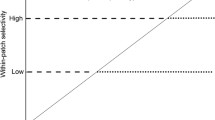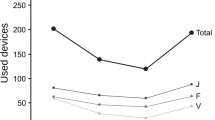Abstract
Plant spatial pattern has been considered as one of the most important factors influencing forage selection of herbivores in natural grasslands. Previous work has emphasized the effects of spatial distribution patterns of food resource at the scale of whole plant communities. Our objective was to explore whether changes in spatial patterns of food within a patchy site affected forage selection of sheep within and among patches. We conducted a manipulative experiment using three native plant species of different palatability and abundance to artificially create three different quality patches in each treatment. We compared the effects of aggregated and randomly dispersed patterns, within high, medium, and low quality patches respectively, on sheep forage selection. Effects of plant spatial patterns within a patch on sheep forage selection of the patch itself strongly depended on the patch quality. For high quality patches, random dispersion of food resources significantly decreased sheep consumption of the palatable plant within the patch. This effect was reversed in low quality patches, and was not significant in medium quality patches. Changes in plant spatial patterns within high quality patches greatly influenced sheep forage selection of other patches. However, changes in plant spatial patterns within medium or low quality patches significantly influenced foraging responses of sheep only for high quality patches. We therefore conclude that high quality resource sites are the most influential and susceptible foraging areas. Our results highlight the importance of high quality resource sites when considering grazing grassland conservation and management.





Similar content being viewed by others
References
Bailey DW, Gross JE, Laca EA, Rittenhouse LR, Coughenour MB, Swift DM, Sims PL (1996) Mechanisms that result in large herbivore grazing distribution patterns. J Range Manag 49:386–400
Baraza E, Zamora R, Hódar JA (2006) Conditional outcomes in plant–herbivore interactions: neighbours matter. Oikos 113:148–156
Benhamou S (1992) Efficiency of area-concentrated searching behaviour in a continuous patchy environment. J Theor Biol 159:67–81
Benhamou S (1994) Spatial memory and searching efficiency. Anim Behav 47:1423–1433
Bergman M, Iason GR, Hester AJ (2005) Feeding patterns by roe deer and rabbits on pine, willow and birch in relation to spatial arrangement. Oikos 109:513–520
Boone RB (2007) Effects of fragmentation on cattle in African savannas under variable precipitation. Landscape Ecol 22:1355–1369
Charnov EL (1976) Optimal foraging, the marginal value theorem. Theor Popul Biol 9:129–136
Clarke JL, Welch D, Gordon IJ (1995) The influence of vegetation pattern on the grazing of heather moorland by red deer and sheep. I. The location of animals on grass/heather mosaics. J Appl Ecol 32:166–176
Dumont B, Petit M (1998) Spatial memory of sheep at pasture. Appl Anim Behav Sci 60:43–53
Dumont B, Maillard JF, Petit M (2000) The effect of the spatial distribution of plant species within the sward on the searching success of sheep when grazing. Grass Forage Sci 55:138–145
Dumont B, Carrère P, D’Hour P (2002) Foraging in patchy grasslands: diet selection by sheep and cattle is affected by the abundance and spatial distribution of preferred species. Anim Res 51:367–382
Edwards GR, Newman JA, Parsons AJ, Krebs JR (1994) Effects of the scale and spatial distribution of the food resource and animal state on diet selection: an example with sheep. J Anim Ecol 63:816–826
Edwards GR, Newman JA, Parsons AJ, Krebs JR (1996) The use of spatial memory by grazing animals to locate food patches in spatially heterogeneous environments: an example with sheep. Appl Anim Behav Sci 50:147–160
Fortin D (2003) Searching behavior and use of sampling information by free-ranging bison (Bos bison). Behav Ecol Sociobiol 54:194–203
Frair JL, Merrill EH, Visscher DR, Fortin D, Beyer HL, Morales JM (2005) Scales of movement by elk (Cervus elaphus) in response to heterogeneity in forage resources and predation risk. Landscape Ecol 20:273–287
Fryxell JM, Hazell M, Börger L, Dalziel BD, Haydon DT, Morales JM, McIntosh T, Rosatte RC (2008) Multiple movement modes by large herbivores at multiple spatiotemporal scales. Proc Natl Acad Sci USA 105:19114–19119
Harata M, Kanemaru E, Tobisa M (2006) Patch choice by cattle grazing tropical grass swards: a preliminary study. Appl Anim Behav Sci 97:134–144
Hewitson L, Dumont B, Gordon IJ (2005) Response of foraging sheep to variability in the spatial distribution of resources. Anim Behav 69:1069–1076
Kohler F, Gillet F, Reust S, Wagner HH, Gadallah F, Gobat J-M, Buttler A (2006) Spatial and seasonal patterns of cattle habitat use in a mountain wooded pasture. Landscape Ecol 21:281–295
Kotliar NB, Wiens JA (1990) Multiple scales of patchiness and patch structure: a hierarchical framework for the study of heterogeneity. Oikos 59:253–260
Laca EA (1998) Spatial memory and food searching mechanisms of cattle. J Range Manag 51:370–378
Laca EA, Demment MW (1996) Foraging strategies of grazing animals. In: Hodgson J, Illius A (eds) The ecology and management of grazing systems. CAB International, Wallingford, pp 137–158
Miller AM, McArthur C, Smethurst PJ (2009) Spatial scale and opportunities for choice influence browsing and associational refuges of focal plants. J Anim Ecol 78:1134–1142
Morellet N, Moorter BV, Cargnelutti B, Angibault J-M, Lourtet B, Merlet J, Ladet S, Hewison AJM (2011) Landscape composition influences roe deer habitat selection at both home range and landscape scales. Landscape Ecol 26:999–1010
Newman JA (2007) Herbivory. In: Stephens DW, Brown JS, Ydenberg RC (eds) Foraging: behaviour and ecology. University of Chicago Press, Chicago, pp 175–220
Parsons AJ, Dumont B (2003) Spatial heterogeneity and grazing processes. Anim Res 52:161–180
SAS (1989) SAS for Windows, Version 6.12. SAS Institute Inc, Cary, North Carolina, USA
Senft RL, Coughenour MB, Bailey DW, Rittenhouse LR, Sala OE, Swift DM (1987) Large herbivore foraging and ecological hierarchies: landscape ecology can enhance traditional foraging theory. Bioscience 37:789–799
Stephens DW, Krebs JR (1986) Foraging theory. Princeton University Press, Princeton
WallisDeVries MF (1996) Effects of resource distribution patterns on ungulate foraging behaviour: a modelling approach. For Ecol Manag 88:167–177
Wang L, Wang DL, Bai YG, Huang Y, Liu JS, Fan M (2010a) Spatially complex neighboring relationships among grassland plant species as an effective mechanism of defense against herbivory. Oecologia 164:193–200
Wang L, Wang DL, Bai YG, Jiang GT, Liu JS, Huang Y, Li YX (2010b) Spatial distributions of multiple plant species affect herbivore foraging selectivity. Oikos 119:401–408
Wang L, Wang DL, He ZB, Liu GF, Hodgkinson KC (2010c) Mechanisms linking plant species richness to foraging of a large herbivore. J Appl Ecol 47:868–875
Wang L, Wang DL, Liu JS, Huang Y, Hodgkinson KC (2011) Diet selection variation of a large herbivore in a feeding experiment with increasing species numbers and different plant functional group combinations. Acta Oecol 37:263–268
Ward D, Saltz D (1994) Foraging at different spatial scales: Dorcas gazelles foraging for lilies in the Negev Desert. Ecology 75:48–58
Acknowledgments
We thank Guang Bo Zhang, Chao Feng for help with their technical assistance and Brian J. Wilsey for providing valuable comments on early drafts of this manuscript. This project was supported by the National Natural Science Foundation of China (nos. 31072070, 31070294, 31100331) and the State Agricultural Commonweal Project (200903060-2, 201003019).
Author information
Authors and Affiliations
Corresponding authors
Rights and permissions
About this article
Cite this article
Huang, Y., Wang, L., Wang, D. et al. The effect of plant spatial pattern within a patch on foraging selectivity of grazing sheep. Landscape Ecol 27, 911–919 (2012). https://doi.org/10.1007/s10980-012-9744-1
Received:
Accepted:
Published:
Issue Date:
DOI: https://doi.org/10.1007/s10980-012-9744-1




